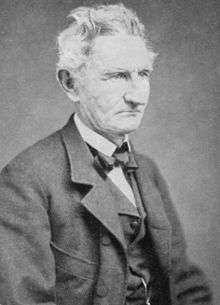John Peter Richardson II
John Peter Richardson II (April 14, 1801 – January 24, 1864) was the 59th Governor of South Carolina from 1840 to 1842.
John Peter Richardson II | |
|---|---|
 | |
| 59th Governor of South Carolina | |
| In office December 9, 1840 – December 8, 1842 | |
| Lieutenant | William K. Clowney |
| Preceded by | Barnabas Kelet Henagan |
| Succeeded by | James Henry Hammond |
| Member of the United States House of Representatives from South Carolina's 8th district | |
| In office December 19, 1836 – March 3, 1839 | |
| Preceded by | Richard Irvine Manning I |
| Succeeded by | Thomas De Lage Sumter |
| Member of the South Carolina Senate from Clarendon District | |
| In office November 24, 1834 – December 19, 1836 | |
| Preceded by | Richard Irvine Manning I |
| Succeeded by | David St. Pierre DuBose |
| Member of the South Carolina House of Representatives from Clarendon District | |
| In office November 28, 1825 – November 24, 1834 Alongside Swepson Cox, William Smith, William Rose, William R. Burgess | |
| Preceded by | Richard Irvine Manning I |
| Succeeded by | David St. Pierre DuBose |
| Personal details | |
| Born | April 14, 1801 Clarendon County, South Carolina |
| Died | January 24, 1864 (aged 62) Fulton, South Carolina |
| Political party | Democratic |
| Spouse(s) | Juliania Augusta Manning Richardson |
| Parents | John Peter Richardson Floride Bonneau Peyre |
Early life and career
Richardson was son of John Peter Richardson and Floride Bonneau Peyre, and grandson of General Richard Richardson (general) of the American Revolution. He was born on Hickory Hill Plantation in Clarendon County. Richardson was educated at Moses Waddel's School in Willington. He graduated from South Carolina College in 1819 and practiced law upon passing the bar. At the age of 24, Richardson was elected to the South Carolina House of Representatives in 1825 and was known as a Unionist during the Nullification Crisis of the early 1830s. He was elevated to the South Carolina Senate in 1834 and won a seat in Congress as a Jacksonian for the 8th district after the death of Richard Irvine Manning I in 1836. Running as a Democrat, Richardson won re-election for a full term to the Twenty-fifth Congress.
As Governor
By the late 1830s, South Carolina's political leaders grew increasingly anxious about the prospects of the Whigs taking control of the federal government and enacting high tariffs. The only option that they felt available to them was the reconciliation of the factions in South Carolina and to put up a united opposition through the Democratic Party. John C. Calhoun, Robert Rhett and Franklin H. Elmore led the effort to unite the Unionists and the Secessionists and one measure undertaken to reunite the factions was the election of Richardson as Governor of South Carolina in 1840. Nonetheless, extreme secessionists opposed a Unionist being governor and James Henry Hammond entered the gubernatorial race to oppose Richardson. The South Carolina General Assembly followed the lead of Calhoun to end the infighting and Richardson was elected governor.
Richardson's term as governor was marked by the Bank of South Carolina refusing to adopt new banking regulations and the enactment of the Tariff of 1842 by the federal government. He promoted the establishment of the South Carolina Military Academy in Charleston because he felt that the militia of the state should be well educated and trained.
Later life
Upon leaving the governorship in 1842, Richardson remained active in politics by participating at the Southern Convention of 1850, the Southern Rights Convention of 1852 and he signed the Ordinance of Secession at the Secession Convention of 1860. He died in Fulton on January 24, 1864, and was buried at the Richardson Cemetery on Hickory Hill Plantation.
External links
- SCIway Biography of John Peter Richardson II
- NGA Biography of John Peter Richardson II
- United States Congress Biography of John Peter Richardson II
- Find a Grave General Richard Richardson
| U.S. House of Representatives | ||
|---|---|---|
| Preceded by Richard Irvine Manning I |
Member of the U.S. House of Representatives from South Carolina's 8th congressional district 1836–1839 |
Succeeded by Thomas De Lage Sumter |
| Political offices | ||
| Preceded by Barnabas Kelet Henagan |
Governor of South Carolina 1840–1842 |
Succeeded by James Henry Hammond |
